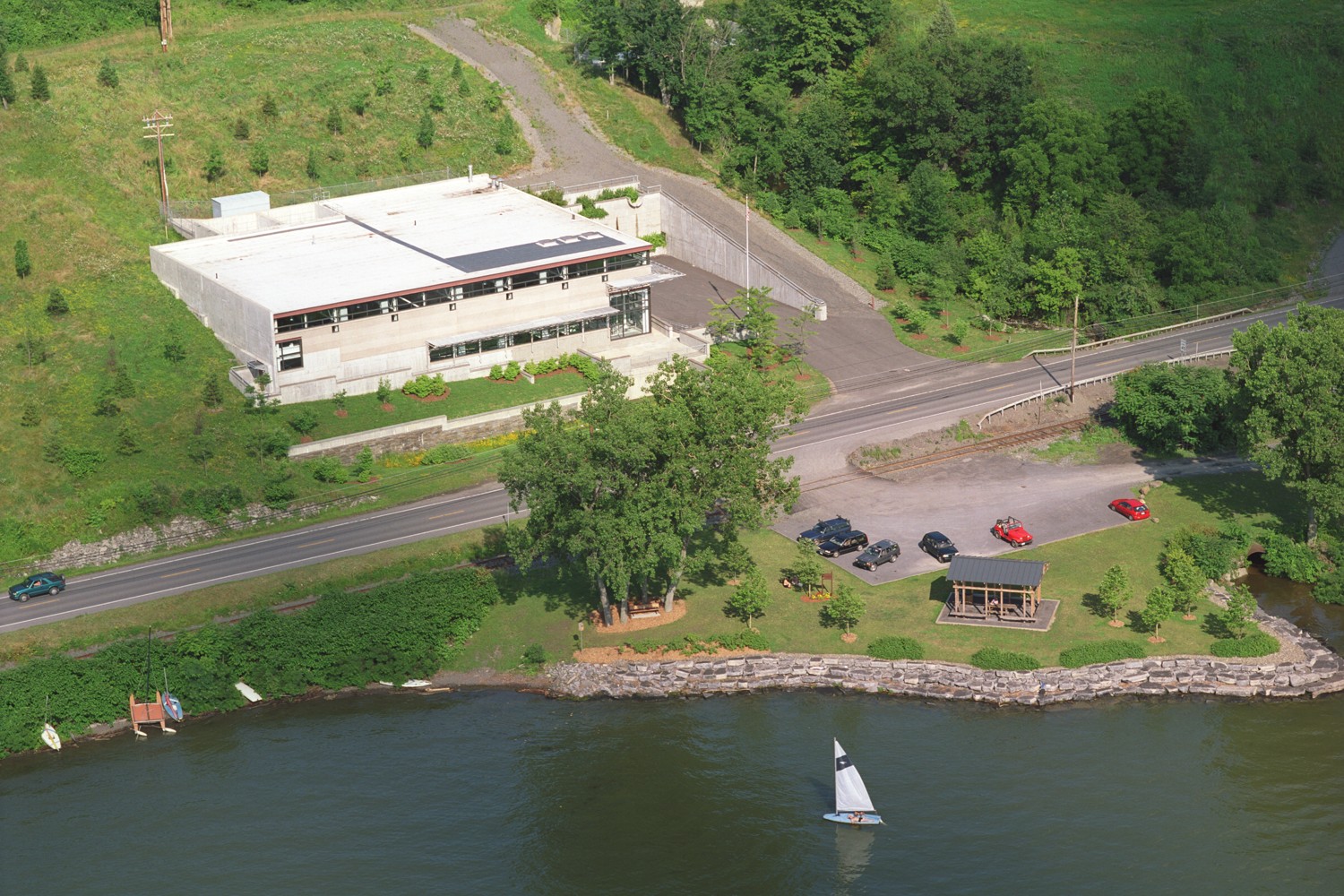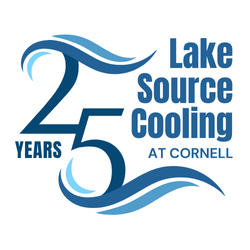Lake Source Cooling Cleaning-2024
The Lake Source Cooling (LSC) system is a remarkable feat of engineering because, in addition to preventing thousands of tons of carbon dioxide from being released into the atmosphere each year, its operations are exceptionally efficient and reliable. Still, over time, tiny, non-native bivalves, called zebra and quagga mussels, build up inside LSC’s water pipes, restricting the flow. In 2024, Cornell’s engineers orchestrated a complex scrubbing project, facilitated by undergraduates and underwater robots, to restore the water flow.
Read on for answers to FAQs developed for the 2024 clean-up project:
1. Why was this work done?
After nine years since the last cleaning in 2015, zebra and quagga mussels (invasive freshwater mussels) colonized the nearly five-foot-diameter intake pipe for the Lake Source Cooling facility. The mussel density had reached the point where the pipe must be cleaned to ensure continuous and efficient operation in hot weather. This maintenance was anticipated during the project design and permitting.
Lake Source Cooling (LSC) provides cooling to Cornell’s buildings using the cold, deep waters of nearby Cayuga Lake instead of conventional refrigeration-based chillers. The LSC heat-exchange process reduces the energy used for campus cooling by over 85 percent and achieves an associated reduction in environmental emissions such as carbon dioxide. Lake Source Cooling has won seven major national and international awards since it started operation in July 2000. It has operated continuously for 25 years, providing the university with nearly all its cooling needs. As part of the permit to operate the LSC facility, Cornell has completed detailed monitoring and analysis. Results demonstrate that the facility has no adverse impacts on Cayuga Lake’s water quality or aquatic life.
2. Is something wrong with Lake Source Cooling?
No. This is standard, anticipated maintenance of the intake piping to remove the non-native zebra and quagga mussels. These mussels are everywhere along the shoreline and all over the bottom of Cayuga Lake, the Finger Lakes, and the Great Lakes. Zebra and quagga mussels are invasive species that are native to Eastern Europe, and were first discovered here in the late 1980’s. The mussels were transported to U.S. freshwaters in the ballast tanks of ships originating in Europe.
The mussel colonization of the intake pipe was inhibiting the flow of water, and it was time to clean the pipe and push the mussels and their debris back into the lake. Once the pipe was cleaned, the flow of water was restored, allowing full operation in future years, and reducing energy use needed to operate the plant.
3. Does the Lake Source Cooling operating permit authorize this activity?
Yes, the permit authorizes this maintenance activity. Cleaning the intake pipe periodically to mechanically remove the mussels and push them back into the lake is highly preferable to the many other options commonly used to control mussel growth.
4. Will this project have any impact on drinking water?
No. Drinking water quality will not be impacted by removing the mussels by mechanical “brushing” inside the pipe and moving the mussels and their debris back into the lake. There are enormous quantities of mussels growing and dying all the time in the lake, and the number of mussels inside the intake is just a tiny fraction of all the mussels in the lake.
5. Is the debris that the mechanical cleaning process pushed into the lake naturally occurring material? How is that evaluated and verified?
Yes. The mussel shells, living mussels, and silt in the intake pipe are absolutely the same materials that are widely dispersed and much more concentrated all across the bottom of the lake and along the shorelines. Video of the inside of the intake pipe verified the quantities and materials in the intake pipe are shells, living mussels, and silt (dirt) – just like those same materials that are present all over the lake bottom.
6. Did the removed debris float to the surface, sink to the lake bottom or was it captured somehow?
The removed debris definitely sank to the lake bottom in the cold (39–42 degrees F) deep waters of the lake. They joined the massive quantity of silt and other mussel debris already present on the lake bottom.
7. Did the cleaning of debris cause visible turbidity?
The entire process of cleaning the intake was monitored by a remotely operated vehicle that observed the cleaning process as the debris was pushed out of the intake pipe and onto the lake bottom. There was only a visible turbidity (clouding in the water) change in the vicinity of the intake structure itself. The intake is 250 feet below the surface of the lake, about a mile southeast of the Ithaca Yacht Club in the west center of the lake. The turbidity was not visible, caused no problems, and settled out quickly after the cleaning operation. The turbidity is made up of the same sediments that come down our creeks after every rainstorm, or when high wind and wave action stirs up the lake bottom in the southern basin where water is shallow.
8. Who paid for this work?
Cornell paid for the cleaning and pays for all operations, maintenance and regulatory compliance activities associated with Lake Source Cooling.
9. Are state or local agencies involved?
Yes. The New York State Department of Environmental Conservation (NYSDEC) was fully aware of, and approved, this mechanical cleaning of the intake piping and the intake screen. This work was completely described and analyzed for any environmental impacts it would create in the approved final Environmental Impact Statement in 1998 before LSC began operation in 2000.
10. How often is this supposed to be done?
The frequency will vary based on the rate at which mussels attach to and grow inside the pipe. It was 9 years since the last time the pipe required cleaning in 2015.
11. There seemed to be a lot of equipment out there? What was it all used for?
The intake for Lake Source Cooling is large, and the parts used in the intake screen and the mechanical cleaning operation are also large, requiring us to use a specialty marine contractor and specialty equipment on the water. That equipment requires a stable work platform, which is a barge made from rectangular welded steel boxes that float on the surface and are anchored to the lake bottom in 250 feet of water. There is a crane, air compressor, generator, winches, diving equipment and tools on the barge.
Near shore, there was a small operation and equipment to support work around the outfall pipe.
All equipment and operations were heavily monitored by the contractor, well-lit and well-marked, to ensure public safety on the water. Navigational hazards associated with this project can be found in the Notice to Mariners published by the New York Canal Corporation ( https://www.canals.ny.gov/wwwapps/tas/notices/index.aspx ).
12. Was it safe to sail or swim near the project site?
Swimming and boating were restricted and/or prohibited in the small work areas to ensure public safety. The work had been specifically scheduled at a time of year when swimming is over and public boating is limited (April 8-24, 2024). The contractor ensured that nobody was near the work areas to make sure that the public was safe at all times.
13. How does this pipe cleaning operation relate to the Cayuga Lake Modeling Project?
There is no relationship between the pipe cleaning operation, which is routine maintenance of the facility, and the Cayuga Lake Monitoring Project, which was a detailed investigation of the sources, fate, and impact of phosphorus on the lake ecosystem.
Between 2013 – 2017, Cornell worked with the DEC to complete an extensive array of additional lake monitoring and data analysis in support of the creation of a lake-wide model to understand nutrient, physical, and biological impacts, and behavior in the lake. The model will be used by the DEC to create a phosphorus Total Maximum Daily Load (TMDL) allocation for southern Cayuga Lake to ensure that phosphorus remains below a level that might affect recreation and water supply. The detailed findings of this project are shared through a public process with wide input and participation by the community, the DEC, and the EPA. More information can be found at: https://fcs.cornell.edu/departments/energy-sustainability/utilities/cooling-home/cooling-production-home/lake-source-cooling-home/lake-source-cooling-nysdec-spdes-permit. The entire process was managed by the DEC and reviewed by panels of experts convened and managed by the DEC and the EPA. Additional information can also be found on the DEC website: (https://dec.ny.gov/nature/waterbodies/lakes-rivers/cayuga-lake-cornell-lake-source-cooling ).
14. Who should I contact if I have a question or concern?
Anyone interested in finding out more about the mechanical cleaning of the intake pipe can call the Energy & Sustainability department in Cornell’s Facilities & Campus Services. Stacey Edwards was the Cornell Project Manager and can be reached at (607) 255-0472.
If anyone is interested in talking to the NYSDEC, the contact for this work is Thomas Vigneault in the Syracuse office at (315) 426-7471 or Thomas.Vigneault@dec.ny.gov.


